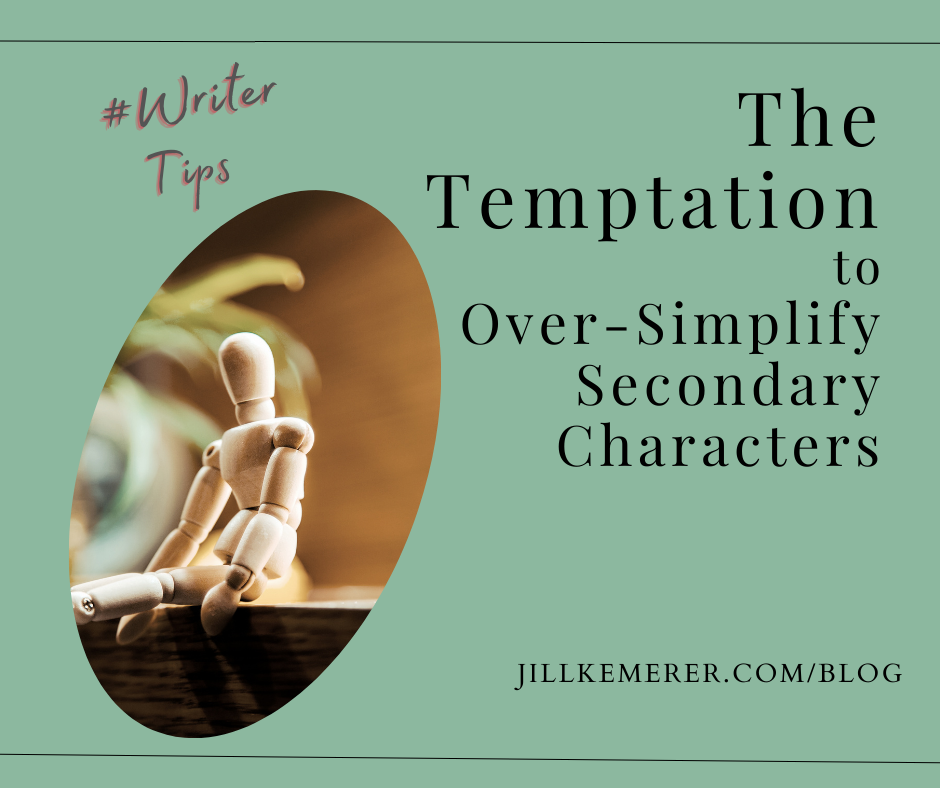My writer productivity skyrockets when I set monthly writer goals, and it’s time to share…
The Temptation to Over-Simplify Secondary Characters
The temptation to over-simplify secondary characters, especially bad guys, hits me every time I write a first draft. Since my books are short, I don’t have much space to devote to sub-plots, and some of the characters are off-camera anyway.
These bad-guy characters are typically exes—ex-boyfriends, ex-wives, ex-in-laws. You know, the people who shaped the main characters’ internal conflicts. The reader needs to know how they affected the characters, and it’s easy to make them caricatures.
Another reason I tend to draft caricatures is because the reader doesn’t get to experience their point of view in my books. I’m only giving the main character’s impression of them, and let’s face, it a one-sided impression tends to be skewed. For instance, the current book I’m writing features a woman whose husband not only demanded a divorce when she told him she was pregnant, but he also wants nothing to do with their unborn child.
He’s not a villain in the sense that he’s stalking her or trying to kill her, but he’s a villain nonetheless.
The problem? Readers don’t want one-dimensional characters, even if he is the jerky ex-husband who is off-page the entire book.
Even if my readers give me a pass, I don’t want to write caricatures. It’s lazy. And it doesn’t reflect reality.
No one is all bad. No one is all good.
Yes…some people are ethically challenged. Other people have very real mental health problems that causes them to make poor decisions. There are also people who live their lives selfishly, not thinking about how their actions affect those around them, and not taking responsibility for it either.
So, there’s the dilemma. How can we write the “bad guy” without making him a caricature? How can we make her a real person, with motivations we might not agree with but we at least understand? And how can we humanize them enough so the reader isn’t taken out of the story wondering, would anyone really act like that?
I’ll be honest with you–there have been times I’ve failed at this. As much as I try to produce multi-dimensional characters, sometimes the cookie-cutter ex shows up.
How to combat over-simplifying secondary characters?
When I have a character (usually from the past who doesn’t play an active role in the book) who caused my heroine or hero a lot of pain, I come up with reasons why this person would behave that way. Jealousy, greed, narcissism, desperation, chemical imbalance, addictions–all of these can bring out the dark side in people.
When I have an idea why the “bad guy” was so awful, I then try to incorporate this into the main character’s thoughts 0r even a conversation with someone they trust so the reader gets a better understanding, too.
Going back to my current heroine…she’s long suspected her ex-husband had a personality disorder of some sort. This is confirmed later in the story. Their entire relationship was basically long-distance. They only saw each other a few weekends per month because of his job. These details help the reader understand why the heroine would have married this guy in the first place and gives credence as to why he wants nothing to do with their child.
He’s not an endearing character. His actions affect my heroine. But he’s not evil or just bad to be bad. He has problems, and since he’s chosen to cut himself out of the heroine’s life, there’s not much she can do about it.
If the secondary character plays an active role in the book–say the ex-husband is showing up at her house or she has to work with him and he’s lying about her–I would spend even more time weaving in reasons and motivations for the reader to understand why he’s acting like a jerk. Readers can handle a “bad guy” in the book. They will find him or her more believable if they understand why he or she is acting that way.
Readers don’t have to like every character. The book might be boring if they did! But they do need to understand each character.
The temptation to over-simplify secondary characters is basically telling not showing. Hate this ex-husband because he’s a lying, cheating jerk who doesn’t want the baby!
If that’s all his character is reduce to, it makes me wonder why she married him in the first place? He must have had some redeeming quality, right?
When I’m revising, I actively search for ways to make secondary characters more believable. If the character is a bad guy, I try to either make him or her a little less villainous or weave in more reasons for why they act the way they do.
How do you handle secondary characters who are bad guys? Do you have any tips on making them more believable? I’d love to hear your thoughts!
On a side note, I’m linking an OLD blog post I wrote back in 2014, “Strengthening Weak Areas in Your Writing.” I’m still finding lots of weak areas to strengthen!
Have a great day!





Comments (0)